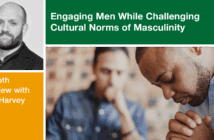
What is the state of clergy health and wellbeing coming out of the pandemic? What factors and practices influence the emotional wellbeing of clergy? Allison Norton describes new research that reveals growing discontentment even though clergy health and wellbeing tends to be better than that of the general public.
Listen on Apple Podcasts | YouTube Music | Spotify
Watch on YouTube
- Transcript — Click or Tap to Read
-
Announcer: Leading Ideas Talks is brought to you by the Lewis Center for Leadership of Wesley Theological Seminary in Washington, DC. Subscribe free to our weekly e-newsletter, Leading Ideas, at churchleadership.com/leadingideas.
Leading Ideas Talks is also brought to you by LPLI. LPLI is a confidential, online, 360º leadership assessment inventory designed to help those working in the church identify individual strengths and weaknesses in order to improve their ministry effectiveness. LPLI is available in both pastor and church staff versions. Learn more about LPLI.
What is the state of clergy health and wellbeing coming out of the pandemic? What factors and practices influence the emotional wellbeing of clergy? Allison Norton describes new research that reveals growing discontentment even though clergy health and wellbeing tends to be better than that of the general public.
Ann Michel: Welcome to Leading Ideas Talks. My name is Ann Michel. I’m a senior consultant with the Lewis Center for Church Leadership of Wesley Theological Seminary, and I’m also one of the editors of our Leading Ideas e-newsletter. It’s my privilege today to serve as your host for this episode of Leading Ideas Talks podcast. My guest today is Allison Norton. She is a Faculty Associate in Migration Studies and Congregational Life at Hartford International University for Religion and Peace. She’s also one of the researchers who’s worked with a major initiative exploring the pandemic’s impact on congregational life. The latest findings of this research initiative have been released and they focus on clergy health and wellness in our post-pandemic times. That’s what we’ll be talking about today. Welcome Allison.
Allison Norton: Thank you, Ann. It’s great to be here with you.
Ann Michel: So, before we get into the subject of clergy health and wellness, can you describe the broader work of the initiative exploring the pandemic’s impact on congregational life, of which this most recent report on clergy health and being is part?
Allison Norton: Yeah. So, this is a five-year study. We are about halfway through, and it is composed of multiple parts. So, this report we’re going to talk about comes from a clergy survey, and we’re doing ongoing national surveys of congregations across the country and regularly we’re producing reports out of this. So, this is our latest national survey. But we also have reports and research that are qualitative in nature. So, there are 81 case study congregations that are partners with us in this research in nine different regions in the U.S. We did field work in 2022. And we’re back in the field right now interviewing church leaders, doing focus group with attenders, participant observation services. So, we’re doing a two-year follow-up to see what changes have occurred in that period.
Ann Michel: So, it’s really comprehensive work.
Allison Norton: That’s right, and then we also have a longitudinal panel. So, it’s a quite robust picture.
Ann Michel: Our podcast listeners may recall that we’ve already interviewed some of your other colleagues on some other aspects of this study. So, it really is quite broad in scope. I think the background of this newest report is the common perception that clergy are exhausted, they’re burned out, they’re dropping out of ministry in droves. I wanted to begin by asking you, how true is that perception?
Allison Norton: Yeah, you’re right. That is the word on the street, right? That is the common perception. What we’ve done in this survey is we’ve actually broken that out into two reports. One is really looking at that dynamic you’re mentioning–around clergy contentment and the factors that are driving them to leave, either having thoughts of leaving their congregation or leaving pastoral ministry altogether, and we do see that those thoughts are on the rise. As we’ve looked at this trend over the last few years, there is a growing clergy discontentment. But what is also fascinating is that when we look specifically at clergy health and wellness, the picture is not as bad as one might think. In fact, when we compare clergy health and well-being to the general public, clergy tend to be quite healthier.
Ann Michel: Yeah, so I think that was one of many somewhat surprising findings of your work, that clergy do seem to be quite mentally and emotionally healthy compared to the general public, even though you’re saying that there has been a rise of discontentment as measured by people thinking about leaving ministry, not necessarily actually leaving ministry.
Allison Norton: That’s right. So, we asked them questions about how often they have these thoughts as well. Because I think we all wake up sometimes and feel like we want to quit our jobs on a stressful day. But really, it’s how often we have those thoughts, right? So that’s another thing that we measured so we could get a good look at what dynamics that are happening that are leading to clergy having these feelings of discontentment. But as you mentioned, it’s surprising when we look at the general public and we see, asking questions like “I am satisfied with my life as a whole these days?” “In general, I usually feel happy.” Looking at these items and questions on a scale, clergy are doing quite well.
Ann Michel: Yeah, that’s really good to hear. So, one thing I wanted to ask is whether you think age is a factor in this. Looking at the demographics in your study, the average age of the clergy that you surveyed is 59, which is, I think, very high in relation to the average age of the general populace. From just my very casual acquaintance with the subject of clergy health and wellbeing, I think it’s generally assumed that as people become more mature, their mental and emotional health tends to improve anyways. So, do you think that age is a factor?
Allison Norton: It absolutely is a factor. So, when we are looking at landscape of how the pandemic has impacted the average age of clergy, one of the things that we do see overall is that clergy do tend to be older. So, when we did our first survey in 2021 the average age of clergy was 57, and it is now 59. So, clergy are older, right? But one of the things that this survey looked at when it comes to health and wellness is exactly what you’re saying. What difference does age make? We compared across generations, and perhaps not surprisingly, a larger percentage of our millennial clergy leaders scored lower on their health and wellness scores compared to their older peers. Our boomer generation clergy were most likely to be in what we call the “good” or the “great” health and wellness category. Gen X was somewhere in between. So, there is an age gap in terms of health and wellness, but this matches what we find in the general population. So, it’s not surprising in the sense that what we see with our millennial generation and certainly Gen Z is matched by what we find in our survey on clergy health and wellness.
Ann Michel: So, I think I’ve neglected to ask, when we’re talking about clergy health and wellness, what is that? How do you measure it? What does it look like? How do you know if clergy are emotionally healthy?
Allison Norton: That’s a great question. Because it is about what we’re measuring, right? What kind of questions are we asking? So, what we did was start with the Harvard Flourishing Study. They ask 11 questions that have to do with things like, “Overall, am I satisfied with my life as a whole these days?” “In general, do I feel happy?” It asks people to rank on a scale from a one to 10 their own physical health, rank their mental health rank, their relational health, etc. So, we added to it six other questions that included some spiritual health aspects as well. Then we combined all 17 of these into a scale so that we were able to have a one to ten ranking to compare the clergy that participated in our study. What was great about using the Harvard flourishing measures is it also allowed us then to compare with the general public, because there’s existing work using these same questions. So, then we could have a comparison with the general public.
Ann Michel: Thank you. I’m imagining that these are relatively standard measures that are used in the field.
Allison Norton: Yes, they are. Yes.
Ann Michel: So, another surprising aspect of this research is that a lot of the behaviors and self-care practices that are commonly assumed to enhance wellbeing in clergy–like taking a day off every week, being part of a peer support group, or seeking counseling or spiritual direction—these things correlated only minimally with health and emotional wellbeing. I think there are some pretty nuanced reasons for this, but is it possible for you to address that briefly?
Allison Norton: Yeah. You’re right. We do tend to think of these things as the standards of clergy self-care. I think one of the explanations, particularly when it comes to, for example, taking a day off a week, right? We didn’t find a large difference in the health and well-being of clergy who did take at least one day off a week and those who did not. I think part of the explanation here is that most, I think about three quarters of the clergy in our study, did take at least one day off a week. So, the vast majority of our participants already were in the habit of taking at least one day off a week. Many of them were also participating in peer support groups, although this has declined over the last few years. I think about two thirds now say that they are participating in some kind peer group with other clergy. But when we look at our open-ended comments and interviews with clergy leaders, it’s clear that they find value in these practices of self-care. So, the survey is not suggesting that there is no value in having a sabbatical, taking a day off, engaging in spiritual direction or therapy. It’s not that these things are not beneficial, but it’s that they didn’t have as strong a correlation to health and wellbeing as some other aspects that relate to the characteristics of the congregations they’re serving and some of their personal dynamics.
Ann Michel: I want to get into some of those things in a minute. But just going back to the question of some of these baseline self-care practices, could it be that because they are common practice, they’re not going to be the variable that accounts for differences?
Allison Norton: Yes, I think you’re right. They have become common practices. Like I said, it’s not that they are not beneficial. We know from our conversations with clergy and the open-ended comments that they are. But, like you’re saying, they’re a common practice and I think they also are part of what drives clergy to seek out wellbeing, right? To do some of the common practices to incorporate them into their life.
 LPLI Helps Good Church Leaders Become Better Church Leaders
LPLI Helps Good Church Leaders Become Better Church Leaders
LPLI Pastor Version | LPLI Staff Version
LPLI is a confidential, online, 360º leadership assessment inventory designed to help those working in the church identify individual strengths and weaknesses in order to improve their ministry effectiveness. LPLI: Staff Version provides better feedback for staff development and includes a free guidebook, Making the Most of LPLI, designed to lead a staff member through a process of analyzing their results, discussing their results with others, and formulating an action plan to improve their effectiveness. Learn more about LPLI Staff Version.
Ann Michel: Another issue is spiritual practices. There, I think, you found more clear-cut evidence that certain spiritual practices, like prayer, meditation, and scripture reading, do make a positive contribution to clergy health. Is that right?
Allison Norton: That is true. Maintaining spiritual practices like prayer, scripture reading, how our respondents ranked the importance of their faith in their daily lives, were associated with their overall health and wellness. So, those who had decreased their prayer or scripture reading or this sense of importance of their faith in their daily lives, also had lower overall health and wellness scores. In fact, none of them scored in the great category who had noted a decrease in these spiritual practices. So not surprisingly, there is a connection between the intensity of religious practices and clergy wellbeing.
Ann Michel: Do you think that’s unique to the calling of clergy? Or would that finding also hold true for people in general?
Allison Norton: We have not studied that. But there are many studies that try to understand the dynamic and the impact of maintaining an active spiritual life, of incorporating spiritual practices, religious, and spiritual practices. There is a body of existing research that would say that for the general person, having an active spiritual life does correlate with increased mental health and wellness.
Ann Michel: So, another surprising factor to me was the issue of loneliness and isolation. I am not a clergyperson, and I think it’s easy for those of us who are not clergy to imagine that it would be almost impossible for a pastor to feel lonely or isolated given the nature of their work. So, I wanted to invite you to talk about this issue of relational wellness and clergy. What were some of the ways that you measured this and some of the conclusions that you came to?
Allison Norton: I think we know that being surrounded by people is not necessarily an antidote to loneliness. You can still feel lonely because a lot of that has to do with, as we found in our study, broader markers of relational health. So, nearly half of the clergy who completed our survey claimed to be frequently or occasionally lonely. This was rather astounding to us, and I think highlighted some of the relational challenges that might be specific to clergy.
I talked about how our study is able to compare with the general public. The one area in which clergy tended to score lower on average than general public did has to do with this concept of relational health. That they had relational health in a way that was perhaps an antidote to loneliness. So, when we look at loneliness with clergy in particular, we were surprised by how common this was. We put together a scale. You asked how we measured this, right? How did we measure this? We put together a scale of several questions, all having to do with relational health. One of them was specifically about loneliness, but the others had to do with questions like: Do you have someone that you can go to when you need help? Are you content with your relationships? Are your relationships satisfying? Do you feel connected to your broader community? Do you have social networks to rely on? So when we put this relational wellness scale together, we found that those who have great relational wellness are rarely lonely.
I think there are ways for clergy to think about their relational health and how they create opportunities for greater connection to their broader communities. One of the things that came up in our stories and conversations with pastors is that they were finding opportunities to build relationships outside of their church, outside of their congregation. So, one mentioned pickleball. He joined the local pickleball group. He plays pickleball, and then he doesn’t have to be the pastor. He can be the pickleball partner. So, I think this says a lot about the connection between relational wellness as an antidote to loneliness.
Ann Michel: So maybe also having relational networks beyond the congregation.
Allison Norton: That’s right. I think another important point here is that we learned in our work that the extent to which a clergy person feels there is a good fit between them and their members is also related. For those that said there was a good fit between them and the members, they had less relational loneliness. Some of that might be important to think about if you’re brand new to a congregation, or there’s conflict in your congregation, or other things that make it difficult to have this sense of good fit between you and your members. Then it’s especially important to find these other sources of community and connection.
Ann Michel: That was actually what I wanted to talk about next. Because not surprisingly, there are congregational factors at play, as well, in determining a clergy person’s sense of wellbeing. At the risk of oversimplifying things, if I’m reading the survey correctly, clergy persons that serve in larger churches, in vital churches, in churches that are more open to change, in churches that have a clear sense of mission and purpose, are more likely to have high wellness scores. Whereas clergy that are serving in smaller or highly conflictual settings, the congregational factors are more likely to be negative. I think this only stands to reason. But I also think it’s worth emphasizing that there is this connection between congregational health and vitality and clergy health and wellness, especially in an era where so many congregations are strained and in decline. This seems like the looming factor that has to be considered for a lot of individual clergy people as well as our systems more generally.
Allison Norton: One clear finding of our study is that there is this mutual relationship between the health and wellbeing of the organization, of the church, and the health and wellbeing of the leader. We’re not saying that one causes the other, but there is a clear correlation. So like you said, denominational family makes some difference. Catholic and Orthodox clergy tend to fall mainly in the “good” relational or “good” mental health and wellness category. The Mainline and Evangelical Protestant clergy were comparable to each other on where they fell on the scale, with the Mainline slightly more in the “good” wellness group and evangelical pastors slightly more in the “fair” category. But church size matters too. The larger the church, the more likely the clergy person will have higher wellness scores, and those serving in small congregations of 50 or less are most likely to have poor wellness scores.
Then some of those attitudes that maybe are harder to quantify, like the church’s orientation toward change. So, how open do clergy think their congregation is to change; to meet new demands, to meet all the challenges that their congregation might be facing. So, if a church is highly open and oriented toward change, the clergy person is also more healthy. If the church has a clear sense of mission and purpose, that relates to the healthiness of the clergy. If the church has high levels of conflict the clergy tend to have lower health and wellness. So, all of these things have a mutual relationship.
Ann Michel: Again, I think that only stands to reason. But then again, you don’t always have control over those factors. Sometimes you do. But a lot of times you don’t. And so it seems they would be natural stressors leading to the idea that “Maybe I don’t want to do this anymore” if the clergy person is in a congregation that is not willing to change, very small, or whatever. That’s an increasing percentage of congregations these days. So, I think that does give pause.
To begin to wrap this up, I wanted to ask about the title of the report, because the title of the report is “Challenges are Great Opportunities.” So, I wanted to unpack that a bit. What do you think is the most significant challenge with regard to clergy health and well-being? What’s the great opportunity that you see? How are they connected, as your title suggests?
Allison Norton: One of the things we’ve seen overall is the pandemic has been a driver of change, not just in congregations, but in our society in many ways. What we saw in the first couple of years after the pandemic is that churches did report these greater levels of willingness to change to meet current needs, realities, and current demands. There was kind of this aspect of forced change that I think was healthy for many congregations. So, this orientation towards a challenge as an opportunity. The challenge might have come, or a crisis may have come, but it’s prompted churches to address and wrestle with realities that they were dealing with long before the pandemic. The pandemic just provided that little spark to really address some of these.
So, I think that’s really the opportunity. The opportunity is for pastors leading congregations through change to take advantage of this moment. Now we do see a bit of a hardening of some of these attitudes, wanting to go back to a status quo, normalizing different patterns, which is why I think the orientation to change remains a factor in all of this. But I think the opportunities here are for clergy to think about what are those dynamics in their control and what are those that are not in their control. Some are things where clergy can bring changes, right? We know that their physical health is related to their overall health, that their financial health is related to their overall health. We know that using resources from their denominations, judicatories, their regions are things that clergy can do, that they have control over that can relate to their financial health and be a real opportunity. On the other side, I think it’s drawing a clergyperson’s attention to these dynamics around conflict, their congregation’s orientation towards change, and perhaps leading right in that, toward thinking about the greater health of the communities that they’re in as well.
Ann Michel: So, it seems like what you’re saying is that “knowledge is power.” The more that congregations and pastors understand the factors that contribute to their mutual thriving, the more control they have over it.
Allison Norton: That’s right. And it’s understanding, out of that knowledge, that wellness requires this holistic approach that is attentive to personal practices, to relationships, to spiritual nourishment, to congregational culture, and the broader systemic factors.
Ann Michel: So, I wanted to ask one final question. I always like to leave our listeners with an action step or a “to do.” So, I wanted to ask, based on your findings, is there one recommendation you would make to a clergyman or a clergywoman to help improve their sense of health and wellbeing? Then is there also one recommendation that you would make to the average congregation?
Allison Norton: Yes. So, to the clergyperson, pay attention to your relationships. Build strong, supportive networks, if not within your congregation, outside of the church walls. Find places of meaning and purpose that are not just in ministry, that can help build relationships with others. This can be one way to lessen what we see with regard to loneliness. Then for congregations, I think it’s seeing your clergyperson as a person, right? Knowing that when there’s conflict, when you feel stress in your own church, the clergy person also feels that stress probably more than you do. So, I think there’s an aspect of empathy toward clergy that is important, and I think a willingness to work alongside to create cultures within the church community that are supportive, not just of congregational health, but of clergy.
Ann Michel: Those are really two great pieces of advice. Thank you, Allison, for this conversation. Also, thank you for this report, which I think provides a lot of really good information, but also really for this entire project of helping us understand where churches are and how they’ve been impacted through this pandemic and post-pandemic period. It’s really valuable information that you are collecting, and I’m grateful for the work that you’re doing. So, thank you.
Allison Norton. Thank you, Ann.
Announcer:Thank you for joining us for Leading Ideas Talks.
Don’t forget to subscribe to our free weekly e-newsletter, Leading Ideas, to be notified when new episodes are published. Visit churchleadership.com/leadingideas.
Challenges are Great Opportunities: Exploring Clergy Health and Wellness in the Midst of Post-Pandemic Malaise is available for download free from the Exploring the Pandemic Impact on Congregation study, funded by Lilly Endowment Inc. and conducted by the Hartford Institute for Religion Research at Hartford International University.
Related Resources
- The Pandemic’s Real Impact on Clergy and Congregations: An In-Depth Interview featuring Scott Thumma — Leading Ideas Talks podcast video | Podcast audio version | In-depth interview
- What Promotes Clergy Wellbeing and Why it Matters featuring Matt Bloom — Leading Ideas Talks podcast episode | Podcast transcript
- 4 Practices to Help Prevent Clergy Burnout by Matt Bloom and Kim Bloom
- The Importance of Holy Friendships by Victoria Atkinson White






